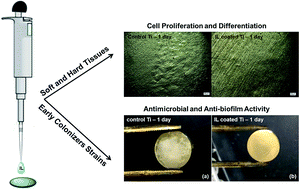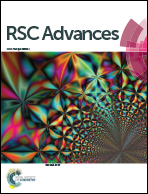Evaluation of mammalian and bacterial cell activity on titanium surface coated with dicationic imidazolium-based ionic liquids†
Abstract
This work presents a new strategy to protect titanium surfaces against bacterial colonization and biofilm formation using dicationic imidazolium-based ionic liquid coatings. Ionic liquids (ILs) were designed as multi-functional coatings and their compatibility with human gingival fibroblasts (HGF-1) and pre-osteoblast (MC3T3-E1) cells was investigated. Results demonstrated that IL coatings were stable and present on titanium surfaces after 7 days of immersion and showed that using phenylalanine as the anionic moiety allowed for cell proliferation and differentiation on titanium surface while also providing strong antimicrobial and anti-biofilm activity against bacterial strains relevant to the oral environment (Streptococcus sp.). Strains such as Streptococcus mutans, S. sanguinis, S salivarius, S. gordonii and S. uberis are known to colonize the surface of dental implants in the early stages after implantation (early colonizers), compromising the success of these devices. The “race for the surface” between cells and bacteria was established by correlating results obtained from cell proliferation (epithelial and osteoblast) and differentiation (osteoblast) studies with that of antimicrobial activity against early bacterial colonizers.


 Please wait while we load your content...
Please wait while we load your content...